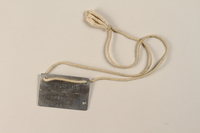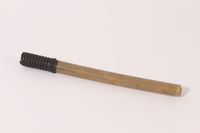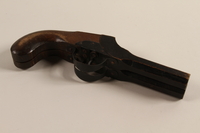Overview
- Brief Narrative
- Brass knuckles used by Salomon (Salek) Strauss in his assumed identity as Tomasz (Timofiej) Marko when he was a labor group leader in Wiener-Neustadt concentration camp in Austria. On September 1, 1939, Nazi Germany invaded Poland and Salomon was mobilized into the 19th Infantry Battalion, Polish Army. On September 16, he was captured as a prisoner of war and taken to Stalag II A in Germany. Salek feared discovery as a Jew and a Communist and created an identity as a Ukrainian, Tomasz Timofiej Marko. He maintained this identity from September 1939- May 1945 in several POW stalags and concentration/labor camps. Salomon was declared a racially pure Ukrainian and released from Stalag VIII-B in February 1941. He was provided training in metal work and made the leader of groups of Ukrainian laborers in Germany and Austria. He was able to travel and provided many with false identification papers. On May 9, 1945, the Wiener-Neustadt region was liberated by the Soviet Army. Salomon identified himself and was arrested by the Soviets, charged with treason, and sentenced to death. He was released with the aid of a Soviet Jewish officer. His entire family was killed by Ukrainian collaborationists in 1943. After the war, he enlisted in the Polish Army. Salomon changed his name to Strauss-Marko to commemorate his wartime ordeal.
- Date
-
use:
1941-1945
- Geography
-
use:
Wiener Neustadt (Concentration camp);
Wiener Neustadt (Austria)
- Credit Line
- United States Holocaust Memorial Museum Collection, Gift of Eva Strauss-Marko
- Contributor
-
Subject:
Salomon Strauss-Marko
- Biography
-
Salomon (Salek) Strauss was born on November 2, 1912 in Warez, Poland, into a religious family. He was the oldest of seven children born in to Lajb Strauss and Szajndla Markus Strauss: Izydor, born 1918; Genek, born 1920; Fanka born 1922; Bejla born 1926; Wilek born1928, and Heniek, born 1930. In 1939, Salek lived in Lvov, in a rented room in the Katz family home. He worked as a tailor, but devoted most of his time to his Communist party activities. He had a girlfriend, Klara Tabak,who lived in a nearbv village, Ksawerowka, with her father, Josef Tabak, and her extended family on the estate of a Polish landowner, whose land they rented. On September 1, 1939, Poland was invaded by Nazi Germany. Salek was mobilized into the 19th Infantry Battalion, Polish Army, which moved west to defend the access to the Polish capital on the Kutno-Warsaw line. On September 16, Salomon and his battalion were captured by the Germans, near Plock. Salek was wounded and placed in a field hospital. There were rumors that the soldiers would be divided according to ethnic groups: Poles, Jews, and Ukrainians, and so on. Salek feared discovery not only as a Jew, but also as a Communist. Since he had been called Tomek by his Polish Communist friends, he considered introducing himself as Tomasz Strauss, and claiming he was German. Instead, he decided to call himself Tomasz Timofiej Marko; Marko after his mother’s maiden name and Timofiej as the Ukrainian version of Thomas. He destroyed his Polish identification, but kept his girlfriend’s photograph, since it was signed only with the letter “K”. He also kept a photograph of his paternal uncle in his WWI Austrian Army uniform, and renamed him Heinrich Marko, in place of Hersz Strauss. The possession of family photographs made it less likely that he would be accused of hiding his background.
The prisoners-of war were moved to Piatek transit camp, and then to Stalag II A Neubrandenburg. Timofiej Marko was given prisoner number 10998. Conditions in the stalag were terrible: prisoners were routinely beaten by the German guards, hunger and disease was widespread, and there was little protection from the harsh weather. Timofiej introduced himself as a former medical student who worked as a metal worker. He claimed that he was the illegitimate son of a washwoman in Lvov and worried that he was not receiving any mail from her. A group of POWs was transferred to Alt-Gutendorf and Neu-Gutendorf camp where conditions were even worse. The prisoners did not work on Sundays, but on days they did not work, they did not receive food. They wore the same Polish army uniforms in which they were captured and their shoes were falling apart. Soon after Christmas 1939, there was a rumor of a prisoner exchange with the USSR, but nothing came of it. In April 1940, Salek/Timofiej was transferred to Kafelsdorf POW camp. He was placed with a farmer, Lindenburg, where he was given ample food and shelter. In September 1940, the group was transferred to Stalag VIII-B - Lamsdorf (Lambinowice). All Ukrainian POW’s were gathered in this camp and a special commission searched within the group to make sure that they were “pure blood” Ukrainians. Timofiej had grown a typical Ukrainian mustache and knew Ukrainian customs, and passed as a Ukrainian. At a later stage, the Germans decided to select a group of Ukrainians to be designated as racially pure and able to live with the German race. A medical exam was required to pass this test. Timofiej was circumcised and so terrified of being discovered as a Jew that he stitched his foreskin with needle and thread. The doctor barely looked at the genitals and the subsequent medical exams concentrated on teeth, lungs, and muscles. The idea of a Jew having passed unnoticed this long was nearly unthinkable, and without that suspicion, the racial science inquiries did not focus on that question. The camp had no checks for venereal disease, as the prisoners had no sexual contact for years. Timofiej was declared a racially pure Ukrainian who deserved to be released from the POW camp and live among the German people. There was a shortage of German males and it was expected that these men would marry German women and procreate.
On February 28, 1941, Timofiej, now Tomasz, Marko was officially released from Stalag VIII-B POW camp. He was in a group of 210 men who were given additional blood tests, then divided into two groups. One group was sent to school in Wiener-Neustadt. Tomasz was in the group sent to school in St. Polten-Viehofen where he learned metal work. He soon became the representative of the student group, as he spoke both German and Ukrainian and was the only one who could communicate with the German authorities. Several other groups of Ukrainian laborers arrived at this school and Tomasz was put in charge of making lists with their names. He slowly became recognized as a leader and a representative of the Ukrainian and Byelorussian laborers.
He had begun making contacts with Austrian Communist groups, when he heard rumors about an upcoming German attack on the Soviet Union. Tomasz decided to use the pretext of a visit to Wiener-Neustadt to go to the Soviet consulate in Vienna to warn them. He entered the Soviet consulate and shared his news. He explained that he was a Jew living undercover and had heard that the Germans were forming a Ukrainian military unit to join in the attack on USSR, with the goal of forming an independent Ukraine. This Ukrainian unit was to join SS- Galizien in spring 1941. A few months later, Tomasz and his group were transferred to work in Ober-Grafendorf in Austria, where military airplane parts were produced and supplied to the main factory in Wiener-Neustadt. Again, Marko quickly became the representative of the foreign workers. With the help of an office secretary, he exchanged a few letters with his girlfriend, Klara Tabak. After a few months, Tomasz befriended Mr. Klor, a former Austrian Social Democrat and head of a Sonderabtailung, a special military unit, in Wiener-Neustadt. Klori ssued a permit that allowed Tomasz to travel throughout the German occupied territory. In winter 1942, Tomasz received time off from work and traveled to Lvov. He visited Klara and her family and learned that his own family had moved from their hometown of Warez to Gole Gory, near Zloczow. Tomasz visited relatives in the Lvov ghetto, and then traveled to Gole Gory. It was very upsetting for Tomasz to see his family so destitute. He provided them with food and merchandise to sell and promised to return within a few months with false papers for his parents, two sisters, and two brothers. At the last moment, Tomasz asked to take his 16 year old sister Bejla with him, but his mother refused. Marko was still passing as a Ukrainian, and heard many expressions of hatred towards the Jews from the local population. He returned to Wiener-Neustadt and his responsibilities grew. His status was further increased during a visit by Hermann Goering a few months later. He organized another home leave for Ukrainian workers and included himself on the list. Tomasz arranged false papers for his family and Klara. In November 1943, Tomasz arrived in Lvov, but the ghetto did not exist anymore and the Jews had been murdered or deported. On his way to Sokal to find Klara he overheard graphic conversations between the locals about the murder of the Jews. He heard descriptions of rapes and tortures of Jews in his hometown of Warez and he recognized the names of the victims. Wherever Tomasz went, he heard horrifying details about the destruction of the Jews of Galicia.
Upon reaching Gole Gory, Tomasz learned that all of his loved ones had been murdered brutally by local Ukrainian collaborators. On December 13, 1943, Tomasz returned to Lvov, where he destroyed the false documents he had prepared. He returned to Wiener-Neustadt, where he continued his official work as the representative of foreign laborers and unofficially helped many to survive with false identification papers. On May 9, 1945, the Red Army liberated the area and Tomasz (Timofiej) Marko yelled to them: my real name is Salomon Strauss. The Soviets immediately arrested him for treason. Salomon was sentenced to death and placed on death row. Due to a loophole left by a Soviet Jewish officer who interrogated Salomon, he was finally released. Salomon Strauss decided to change his last name to Strauss-Marko to commemorate his wartime ordeal. He enlisted in the Polish Army and enrolled as a law student at Łódź University and graduated with a law degree in 1955. In March 1957, Salomon traveled to Lvov and attended Friday night services at the local synagogue. He met Arkadji Schneiderman, who invited him home. Salomon accepted the invitation and immediately fell in love with Ewa (Eva), Arkadji’s daughter. The attraction was mutual and the young violinist married Salomon Strauss-Marko on March 18, 1957. The next day, Salomon had to return to Poland. It took Ewa more than six months to obtain all the permits to emigrate there. She was promptly engaged by the Warsaw Philharmonic Orchestra. A son was born on October 19, 1958. In 1971, the Strauss-Marko family immigrated to Israel. Salomon found employment at the library of Tel-Aviv University and Eva was accepted in the first violin section of the Israel Philharmonic Orchestra under the direction of Zubin Metha. Salomon, age 80, died on April 12, 1992.
Physical Details
- Classification
-
Weapons
- Category
-
Percussive weapons
- Object Type
-
Brass knuckles (lcsh)
- Physical Description
- Silver colored metal knuckle busters with a curved bar shaped grip with a short extension that supports 4 finger holes topped by diamond shaped pointed spikes. The grip that fits into the palm of a closed fist; one side is worn. The grip center is smooth and the outer sides of the base and handle are stippled with a smooth border. There is an embossed snake on the grip. The grip rests in the palm of the hand to absorb the force of the punch, which is given extra power and weight by the use of the knuckles.
- Dimensions
- overall: Height: 2.750 inches (6.985 cm) | Width: 4.375 inches (11.113 cm) | Depth: 0.500 inches (1.27 cm)
- Materials
- overall : metal
Rights & Restrictions
- Conditions on Access
- No restrictions on access
- Conditions on Use
- No restrictions on use
Keywords & Subjects
Administrative Notes
- Legal Status
- Permanent Collection
- Provenance
- The brass knuckles were donated to the United States Holocaust Memorial Museum in 2004 by Eva Strauss-Marko, wife of Salomon Strauss-Marko.
- Funding Note
- The cataloging of this artifact has been supported by a grant from the Conference on Jewish Material Claims Against Germany.
- Record last modified:
- 2023-09-01 08:39:21
- This page:
- https://collections.ushmm.org/search/catalog/irn522369
Download & Licensing
In-Person Research
- By Appointment
- Request 21 Days in Advance of Visit
- Plan a Research Visit
- Request to See This Object
Contact Us
Also in Salomon Strauss-Marko collection
The collection consists of artifacts: a dog tag, a nightstick, a pair of brass knuckles, and a bootjack, correspondence, documents, a manuscript, and photographs relating to Salomon Strauss-Marko, originally from Warek, Poland, during the Holocaust when he lived under a false identity as a Ukrainian while imprisoned in a prisoner of war camp in Germany and in concentration/labor camps in Austria.
Date: 1941-1946

Prisoner id tag issued to a Polish prisoner of war passing as Ukrainian in a German stalag
Object
Prisoner identification tag, stamped #10998, issued to Salomon Strauss when he was held as a prisoner of war in Stalag II A in Neubrandenburg, Germany. On September 1, 1939, Nazi Germany invaded Poland and Salomon was mobilized into the 19th Infantry Battalion, Polish Army. On September 16, he was captured as a prisoner of war and taken to Stalag II A. Salek feared discovery as a Jew and a Communist and created an identity as a Ukrainian, Tomasz Timofiej Marko. He maintained this identity from September 1939- May 1945 in several POW stalags and concentration/labor camps. Salomon was declared a racially pure Ukrainian and released from Stalag VIII-B in February 1941. He was provided training in metal work and made the leader of groups of Ukrainian laborers in Germany and Austria. He was able to travel and provided many with false identification papers. On May 9, 1945, the Wiener-Neustadt region was liberated by the Soviet Army. Salomon identified himself and was arrested by the Soviets, charged with treason, and sentenced to death. He was released with the aid of a Soviet Jewish officer. His entire family was killed by Ukrainian collaborationists in 1943. After the war, he enlisted in the Polish Army. Salomon changed his name to Strauss-Marko to commemorate his wartime ordeal.

Rubber truncheon used by a Polish prisoner of war passing as Ukrainian in a German stalag
Object
Rubber baton used by Salomon (Salek) Strauss in his assumed identity as Tomasz (Timofiej) Marko when he was a labor group leader in Wiener-Neustadt concentration camp in Austria. On September 1, 1939, Nazi Germany invaded Poland and Salomon was mobilized into the 19th Infantry Battalion, Polish Army. On September 16, he was captured as a prisoner of war and taken to Stalag II A in Germany. Salek feared discovery as a Jew and a Communist and created an identity as a Ukrainian, Tomasz Timofiej Marko. He maintained this identity from September 1939- May 1945 in several POW stalags and concentration/labor camps. Salomon was declared a racially pure Ukrainian and released from Stalag VIII-B in February 1941. He was provided training in metal work and made the leader of groups of Ukrainian laborers in Germany and Austria. He was able to travel and provided many with false identification papers. On May 9, 1945, the Wiener-Neustadt region was liberated by the Soviet Army. Salomon identified himself and was arrested by the Soviets, charged with treason, and sentenced to death. He was released with the aid of a Soviet Jewish officer. His entire family was killed by Ukrainian collaborationists in 1943. After the war, he enlisted in the Polish Army. Salomon changed his name to Strauss-Marko to commemorate his wartime ordeal.

Bootjack used by a Polish prisoner of war passing as Ukrainian in a German stalag
Object
Bootjack used by Salomon (Salek) Strauss in his assumed identity as Timofiej Marko when he was a prisoner of war in Stalag II A in Germany and a leader of forced labor groups in Wiener-Neustadt concentration camp in Austria. On September 1, 1939, Nazi Germany invaded Poland and Salomon was mobilized into the 19th Infantry Battalion, Polish Army. On September 16, he was captured as a prisoner of war and taken to Stalag II A. Salek feared discovery as a Jew and a Communist and created an identity as a Ukrainian, Tomasz Timofiej Marko. He maintained this identity from September 1939- May 1945 in several POW stalags and concentration/labor camps. Salomon was declared a racially pure Ukrainian and released from Stalag VIII-B in February 1941. He was provided training in metal work and made the leader of groups of Ukrainian laborers in Germany and Austria. He was able to travel and provided many with false identification papers. On May 9, 1945, the Wiener-Neustadt region was liberated by the Soviet Army. Salomon identified himself and was arrested by the Soviets, charged with treason, and sentenced to death. He was released with the aid of a Soviet Jewish officer. His entire family was killed by Ukrainian collaborationists in 1943. After the war, he enlisted in the Polish Army. Salomon changed his name to Strauss-Marko to commemorate his wartime ordeal.
Salomon Strauss-Marko papers
Document
The papers consist of photographs, documents, letters, identification cards, and a manuscript relating to the experiences of Salomon Strauss-Marko during the Holocaust. The photographs depict Salomon Strauss-Marko during World War II when he pretended to be a Ukrainian under the false name of "Timofiej Marko." The letters were written by forced laborers under Strauss-Marko's supervision to "Timofiej Marko" requesting help or thanking him for help.



